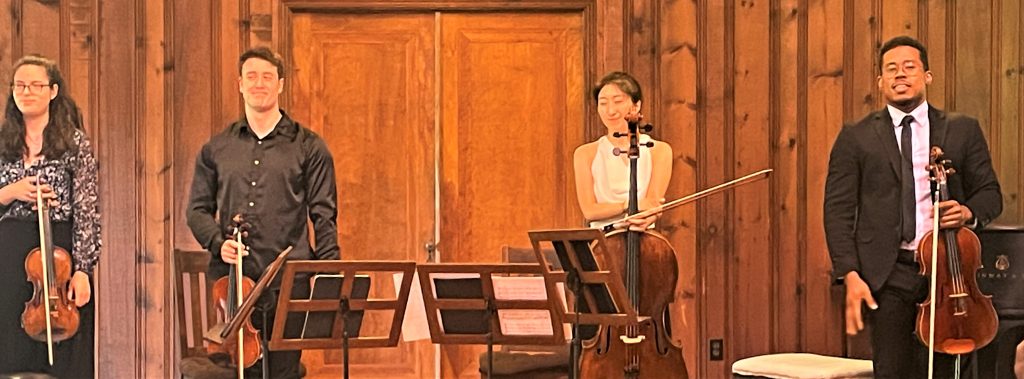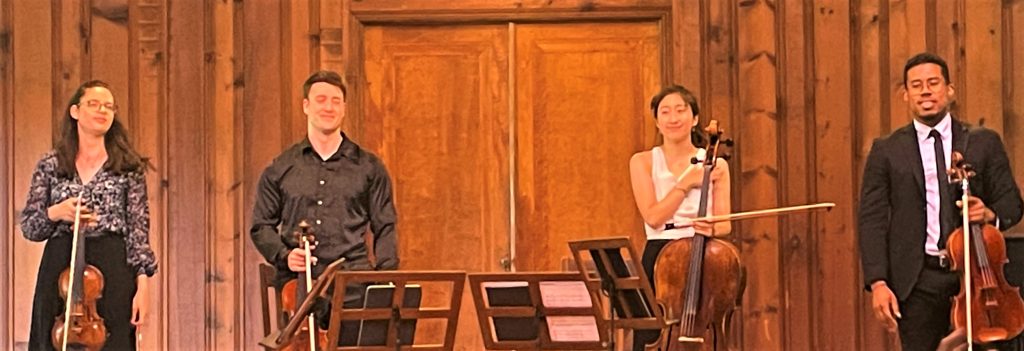
by Kevin T McEneaney
The Dior Quartet was formed in the Fall of 2018 at the Jacobs School of Music, Indiana University under the tutelage of the Pacifica Quartet. They studied with members of the Alban Berg, St. Lawrence, Danish, Artemis, and Belcea Quartets.
They opened with String Quartet No. 3 (2014) by Kevin Lau (b. 1982). Lau is an eclectic, post-modern, Canadian pianist-composer who prizes a shifting flow of lyricism underpinned by a restless rush of changing meters. His music takes us through the diverse rooms of his memory museum as he combines pop musical elements with traditional classical music. His compositions have been performed in the USA, Denmark, Italy, France, Germany, Austria, the Czech Republic, and Hong Kong. He has just completed his first opera, Kimiko’s Pearl.
Gliding, the opening movement of the quartet, offers a bookend arch with a Far Eastern melody mixed with a Renaissance chorale motif which brackets heavy metal rhythms that open a portal to the present. I found the much longer second movement, Winds of Change, far more interesting with its driving, racing rhythm with an exciting lyrical edge which I found delightful. At one point there was a short cello solo by Joanne Yesol Choi that was eloquently resonant.

They performed String Quartet in C Major, Op. 74, #1 (1793) by Franz Joseph Haydn (1732-1809). In 1794 Hayden packed his bag with two new symphonies (Nos. 100 and 101), plus the series of three new quartets (cited above) which were written to please English violin superstar Johann Peter Salomon, who had arranged the London premiere for Franz.
These three quartets mark a change in Haydn’s style from the intimate themes of his previous quartets: these new quartets were broadly orchestral and aimed at a general audience while featuring bravura passages for the first violin, played here by Noa Sarid with exuberant ecstasy. The works that Haydn brought with him were the first synthesis of the classical tradition with the early stirrings of German Romanticism which would usher in a new cultural period.
The Dior Quarter offered a strikingly polished performance with Caleb Georges on viola, Choi on cello, and Tobias Elser on second violin as Noa Sarid delivered searing high notes that pierced the heavens with plangent enthusiasm.

After Intermission, they performed String Quartet # 3 (2020) by Robert Paterson (b. 1970). The five movements of this postmodern work are varied with an emphasis on how the singing voice functions in a musical setting. “Twist and Shout” offers alternative riffs on the popular Beetles mega-hit with excellent effects by Caleb Georges on viola. “Poet Voice,” composed by Paterson for a poet friend who was not a good public reader exalts the imagery of a poem, “The Wild Iris,” where Noa Sarid delivered deep emotion. “Auction Chant” offered amusing satire on auction rhythms where second violinist Tobias Elser romped with abandon. “Effects Pedal” addressed odd pedal percussion in pop music and here Choi on cello provided a humorous edge. “Anthem” engaged all players to meld on the harmonies of about twenty different approaches to an anthem as if the quartet was presenting a rapid-flick slide show!
For the finale, they played The Disappearance of Lisa Gherardini by Dinuk Wijeratne (b. 1978) which demanded some madcap spoken word choreography by Noa, who performed marvelous comic gestures during the performance. Inspired by the legendary theft of Leonardo da Vinci’s Mona Lisa from the Paris Louvre Museum in 1911, Wijerante (a conductor, pianist, and composer) created a contemporary soundscape work of program music for the competition. Born in Sri Lanka, he studied under composer John Corigliano at Julliard, then moved to Ottawa. They opened with an arresting, suspenseful theme delineating skullduggery. I was startled and quite pleased by the minimalist high notes of Noa’s violin, then the low, creepy notes emitted by Choi’s cello which present a grounded portrait of the earthy woman whose smile has become an epic enigma. Once the inside job theft was completed by the former museum employee who had hidden in a closet, second-movement violins screeched like sirens. I thought the third movement to be the most interesting: the question of what this lady might think of the whole caper from Leonardo to today…. The conclusion paints a portrait of Mona Lisa looking at the audience and demanding a reply, which, of course, was raucous applause by the audience!
This was a delightful concert by a young quartet whose reputation is on the rise as they tour with performances at leading venues. I hope they will return next year with a new menu of exuberant performances….

Next Sunday at Music Mountain:
Penderecki String Quartet & Anya Alexeyev, Piano
Franz Joseph HAYDN String Quartet in C Major, Opus 20, #2, “Sun”
Sergei PROKOFIEV String Quartet in F Major, Opus 92
Edward ELGAR Piano Quintet in A Minor, Opus 84